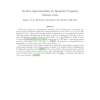Free Online Productivity Tools
i2Speak
i2Symbol
i2OCR
iTex2Img
iWeb2Print
iWeb2Shot
i2Type
iPdf2Split
iPdf2Merge
i2Bopomofo
i2Arabic
i2Style
i2Image
i2PDF
iLatex2Rtf
Sci2ools
FOCS
2005
IEEE
2005
IEEE
On Non-Approximability for Quadratic Programs
This paper studies the computational complexity of the following type of quadratic programs: given an arbitrary matrix whose diagonal elements are zero, find x ∈ {−1, +1}n that maximizes xT Ax. This problem recently attracted attention due to its application in various clustering settings (Charikar and Wirth, 2004) as well as an intriguing connection to the famous Grothendieck inequality (Alon and Naor, 2004). It is approximable to within a factor of O(log n) [Nes98, NRT99, Meg01, CW04], and known to be NP-hard to approximate within any factor better than 13/11 − for all > 0 [CW04]. We show that it is quasi-NP-hard to approximate to a factor better than O(logγ n) for some γ > 0. The integrality gap of the natural semidefinite relaxation for this problem is known as the Grothendieck constant of the complete graph, and known to be Θ(log n) (Alon, K. Makarychev, Y. Makarychev and Naor, 2005 [AMMN]). The proof of this fact was nonconstructive, and did not yield an explici...
Famous Grothendieck Inequality | FOCS 2005 | Integrality Gap | Theoretical Computer Science | Various Clustering Settings |
Related Content
| Added | 24 Jun 2010 |
| Updated | 24 Jun 2010 |
| Type | Conference |
| Year | 2005 |
| Where | FOCS |
| Authors | Sanjeev Arora, Eli Berger, Elad Hazan, Guy Kindler, Muli Safra |
Comments (0)

